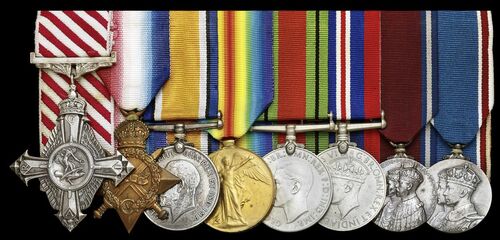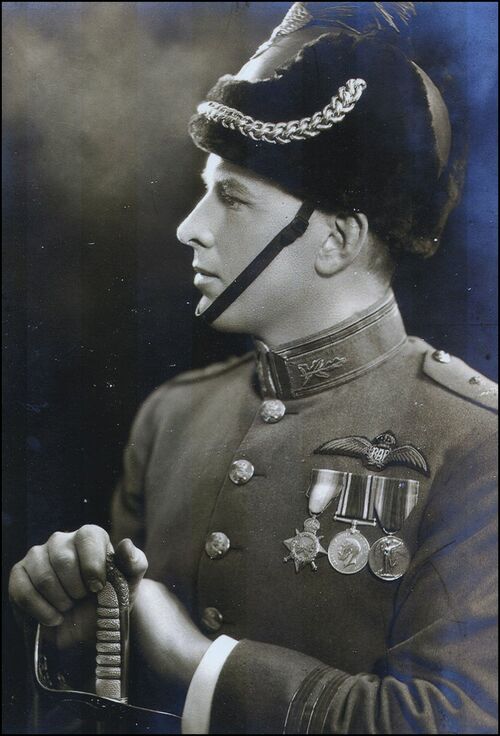Auction: 23003 - Orders, Decorations and Medals
Lot: 322
A 1933 A.F.C. group of eight to Group Captain E. R. Openshaw, Royal Air Force and Royal Flying Corps, late Somerset Light Infantry
Air Force Cross, G.V.R., the reverse additionally engraved 'Squadron Leader E. R. Openshaw R.A.F. July 11th 1933'; 1914-15 Star (2. Lieut. E. R. Openshaw. Som. L. I.); British War and Victory Medals (Capt. E. R. Openshaw. R.A.F.); Defence and War Medals 1939-1945; Jubilee 1935; Coronation 1937, some light contact marks to the first four, otherwise very fine (8)
A.F.C. London Gazette 3 June 1933:
'Exceptional keeness and ability in his work. Responsible for experimenting and developing new ideas for fighter attacks. Due to his personal initiative, energy, and fine leadership in the air that certain definite conclusions have been reached with regard to tactics to be adopted in fighter Sqdns and also that his Sqdn has attained its present high state of efficiency.'
Edward Reginald Openshaw was born in Axbridge, Somerset on 5 April 1895 and was educated at Uppingham (West Bank). Commissioned 2nd Lieutenant in the 1/4th Battalion, Somerset Light Infantry in 18 August 1914 there is some uncertainy as to where he entered the war. The M.I.C. states that he joined the war in September 1914 however the role for the 1914 Star places him at Hafiz (theatre code 5G) in August 1914. Regardless Openshaw certainly saw time in Mesopotamia with his battalion before transferring to the Royal Flying Corps in May 1917.
Later advanced Captain in October 1917 he was posted as a pilot for operational flying to 209 Squadron, flying Sopwith Camels, at Izel-le-Hameau, France, in September 1918. The squadron was engaged in fighter and ground attack missions for the remainder of the war. Openshaw’s copied log books for the period record several attempted dog fights, and a number of ground attack sorties. He obtained a permanent commission to the Royal Air Force in 1919, and was posted to H.M.S. Furious as a Deck Pilot in June of the same year.
Openshaw subsequently served with H.M.S. Argus, and had postings at Leuchars and Gosport. Joining 19 Squadron in April 1929, he was advanced Squadron Leader and appointed to the command of 111 Squadron, flying Siskins and Bulldogs, at Hornchurch in November 1930. Here his efforts to innovate the Squadron's fighter tactics proved immensely successful and resulted in a recognition in the form of the Air Force Cross.
Undertaking a specialist armament course at the Air Armament School, Eastchurch, in 1934, he was subsequently posted to the Middle East Headquarters in Cairo. Advancing to Wing Commander on 1 January 1937 he was appointed on the Staff at R.A.F. Uxbridge. Openshaw was still performing his role there on the outbreak of the Second World War. Further advanced Group Captain on 1 March 1940, he served as Station Commander at R.A.F. West Freugh with No. 13 Group, Bomber Command in September 1940.
Subsequently he commanded No. 1 Air Observer School, Wigtown and No. 2 Air Gunner School, Dalcross. Openshaw was seconded as a liaison officer to the Boulton Paul Aircraft Company in June 1943. He retired in May 1946, and was appointed a Justice of the Peace for Somerset in 1952. Openshaw resided at Barrows Croft, Cheddar, Somerset, and died in 1974; sold together with photographic images of recipient and extensive copied research, including photocopies of several original documents such as commissions, and recipient’s flying log books.
Subject to 20% VAT on Buyer’s Premium. For more information please view Terms and Conditions for Buyers.
Sold for
£1,200
Starting price
£1100







